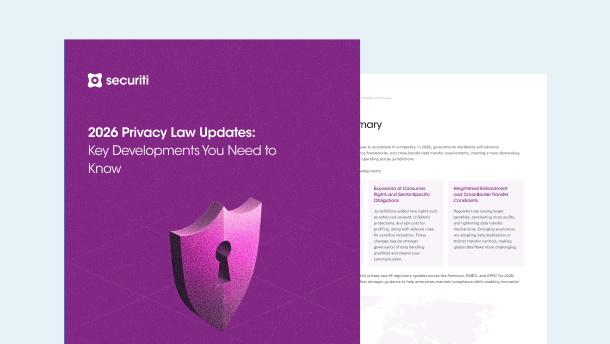Data continues to flood into companies from all directions. From website clickstreams and social networks to IoT sensors and connected devices, enterprises are increasingly embracing data streaming services to accelerate the delivery of new applications, intelligence, and experiences.
But as the ecosystem grows increasingly complex, so does the challenge of mitigating the security vulnerabilities associated with unmanaged sensitive data.
Today’s enterprises must strike a balance between protecting sensitive data and making it accessible to extract business value. To achieve this balance, it’s critical to gain visibility into sensitive data that moves downstream.
Three persistent sensitive data challenges
While most enterprises have tools for managing and monitoring sensitive data at rest, they’re rarely equipped to manage sensitive data in motion in the cloud. Comprehensive protection requires data flow intelligence and governance for today’s modern cloud data architectures. Organizations face three key challenges related to governing sensitive data in cloud data streaming services.
#1 Data sprawl
Data is everywhere and continues to expand. Uncontrolled data sprawl — including potentially sensitive data residing in newly created topics without traceability or known owners — increases the chances that sensitive data could be exposed jeopardizing a company’s reputation and increasing the risk of steep penalties for regulatory non-compliance.
Streaming services like Apache Kafka, Confluent Kafka, and Google Pub/Sub live in cloud environments and stream data between multiple data stores via buses to move data traffic between various cloud-based systems.
Data published to a streaming service is distributed to multiple systems automatically.
Consumers and systems that subscribe to a topic have access to all data within that topic and can import it into their own systems or republish it. If a stream contains sensitive data, that data will be compromised further if a subscriber exposes it or sends it downstream.
To counter this, businesses need a solution that can rapidly scan and identify sensitive data, classify it, and assign the appropriate remediation or masking policy to protect it. Understanding where sensitive data resides, how much of it exists, and where or how else it may be accessed is a vital step in helping to control the widespread impact of sensitive data sprawl because an organization can only limit how much and what types of data are published downstream once it understands where data is coming from and where it’s going.
#2 Process controls
For modern enterprises, the obligations and responsibilities around data are highly complex and nuanced. Companies must comply with ever-changing global and local regulatory requirements, such as General Data Protection Regulation (GDPR) and the California Privacy Rights Act of 2020 (CPRA). But achieving compliance without the benefit of knowing what sensitive data exists, where it resides, and who can access it is nearly impossible.
Complex streaming architectures make it difficult for organizations to have insight into whether sensitive data is being sent downstream — and if so, what type. Myriad consumers can subscribe to a single topic and if sensitive data is unwittingly written to a topic, it can spread rapidly, exponentially increasing risk.
Although streaming solutions provide the ability to specify what roles can access what data, it is nearly impossible for administrators to set up subscriber access policies based on the underlying sensitivity of the data. There is simply no easy way to know if a topic contains sensitive data.
Solutions that help administrators to map subscriber access policies based on the sensitivity of data in each topic enable more granular classification and tagging of sensitive data. Organizations gain the ability to choose which topics downstream consumers may subscribe to and what data they may consume within each topic.
#3 Balancing data exposure with business use
It’s exceedingly difficult for organizations to leverage data downstream for analytics, insights, and other revenue-focused activities while ensuring that sensitive data does not end up where it can expose the company to risk.
Streaming solutions offer no native ability to change the values for sensitive data in streaming buses to limit exposure. While failing to lock down data comes with enormous risk, locking down data too much limits its intrinsic value.
Organizations can leverage advanced data governance solutions that can effectively mask selected sensitive data before it gets pushed downstream to subscribing systems. Masking policies applied universally and automatically using data tags that specify what data should be masked mean that data can still be used in analytics to promote innovation without exposing the sensitive data values.
Streaming data is a novel threat
While it’s historically been easier for organizations to get their hands around the traditional and confined nature of on-premises environments, the shift to the cloud, combined with the explosion of data streams in cloud environments, has introduced a whole new paradigm of data protection.
Historically, enterprises have focused their efforts on scanning and monitoring data at rest, determining what sensitive data exists in the overall environment. But enterprises usually struggle to match batch data at rest because of the unique architecture and velocity of real-time streams.
As a result, most organizations haven’t made much meaningful progress on defending and securing sensitive data in transit because it’s extremely difficult and doesn’t often align with their established data governance policies.
Traditional data flow
- starts in an application on top of a database.
- flows through an ETL tool.
- pushes into a data warehouse or data marts.
The number of infrastructure pieces that sensitive data has traditionally flowed to is extremely limited and the access to the data movement infrastructure highly limited as well.
But in a cloud streaming environment — with massive volumes of data moving at high velocity — with myriad origination points and destinations, scanning data becomes exponentially harder.
Now, a company might need to scan ten different systems instead of just the originating one.The more subscribed systems there are downstream, the higher the likelihood that sensitive data inadvertently makes its way to some place it’s not intended to go.
The reality is that in a hyperscale multi-cloud landscape, data flows freely within and across various private and public clouds. It’s consumed by large numbers of systems that are also publishing streaming data and moving that data farther downstream and out of the original publisher’s sight.
As a result, enterprises need a solution that can automate this process using AI and machine learning to identify sensitive data. Centralizing sensitive data scanning at the messaging layer allows privacy, security, and governance teams to scan and administer sensitive data, preventing it from being sent downstream.
Centralized data security for siloed environments
Ideally, enterprises would consolidate their data security and governance models to cover both batch and streaming data. Now they can.
Securiti providing stakeholders across the enterprise with real-time visibility and control over sensitive data flowing through popular cloud streaming platforms, so enterprises can:
- Find all their sensitive data
Organizations can have the flexibility to scan data from a central control point before it proliferates to locations that are difficult or costly to scan, as well as in downstream subscribed systems.
- Manage all their sensitive data
Robust role-based permissions help control access to sensitive data within a streaming environment, while advanced masking capabilities allow teams to leverage essential data for maximum business value without exposing sensitive information to unnecessary risk.
- Ensure compliance
Securiti’s scalable, enterprise-grade architecture also includes a host of enhanced compliance features designed to help any organization meet today’s complex and evolving data security, privacy, governance, and sovereignty demands.
Protect Sensitive Data in Streams with Securiti
Every enterprise that leverages streaming environments needs a solution that can handle data in motion and provide intelligence around sensitive data. But most organizations risk exposing sensitive data because they don’t have the right tools and strategies in place.
Securiti solves today’s most challenging data problems by providing a comprehensive solution for data flow intelligence and governance. This solution encompasses sensitive data discovery, scanning, administration, and masking data for today’s modern cloud data streaming services.
Download our white paper to learn more about protecting your sensitive data in transit and at rest…all from a single solution.













































